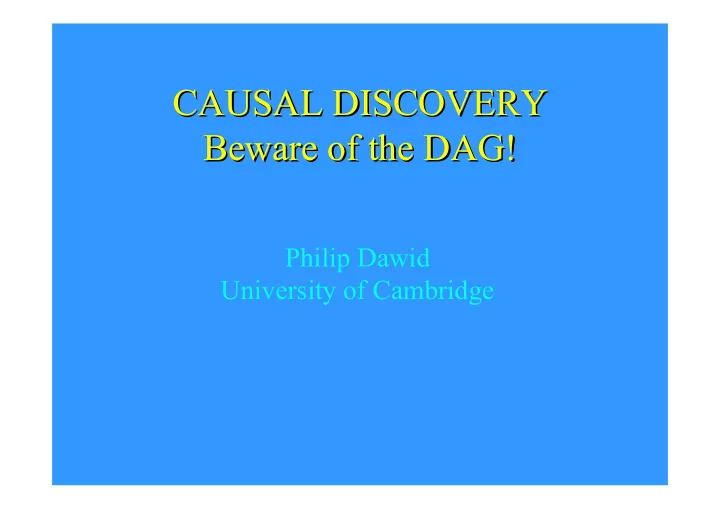

CAUSAL DISCOVERY CAUSAL DISCOVERY Beware of the DAG! Beware of the DAG! Philip Dawid University of Cambridge
Seeing and Doing Seeing and Doing • Causality is about the effects of interventions • To discover these we really should experiment • If we can’t, is there anything sensible we can conclude from observational data? • No amount of clever analysis of observational data can replace experimentation
Seeing Seeing • Association – Describe stochastic dependence and independence • Conditional Independence – We have a formal algebraic theory • Semi-graphoid • Separoid
Properties of CI Properties of CI X ⊥ ⊥ Y | Z ⇒ Y ⊥ ⊥ X | Z X ⊥ ⊥ Y | X X ⊥ ⊥ Y | Z, W ≤ Y ⇒ X ⊥ ⊥ W | Z X ⊥ ⊥ Y | Z, W ≤ Y ⇒ X ⊥ ⊥ Y | ( W, Z ) ⎫ ⎪ X ⊥ ⊥ Y | Z ⎬ ⇒ X ⊥ ⊥ ( Y, W ) | Z. and ⎪ ⎭ X ⊥ ⊥ W | ( Y, Z )
Graphical Representation Graphical Representation • Certain collections of CI properties can be described and manipulated using a DAG • A probabilistic CI property corresponds to a graphical separation property – d-separation – moralization • That’s it!
Example Example U Z T U ⊥ ⊥ Z Z | ( T, U ) Y ⊥ ⊥ Y
Points to Remember Points to Remember • The graph is nothing but an indirect way of describing the CI relationships – cf. regression • Clear semantics of this description • May be several alternative representations (or none) • Arrows have no intrinsic meaning – CI is non-directional! • Represented relationships unaffected by others unmentioned
Doing Doing Augmented DAG with intervention indicators Explicit causal semantics A F A B B ⊥ ⊥ F A | A
“Reification” “Reification” In an associational DAG: • (Some) arrows represent direction of influence, direct cause,… • (Some) directed paths represent causal pathways” • If these exist in all equivalent DAG representations, – or if they can be described in terms of additive noise they are truly causal
A C B A ⊥ ⊥ B | C A ⊥ ⊥ B | C C A B A ⊥ ⊥ B | C A C B C A B A ⊥ ⊥ B A B A ⊥ ⊥ B
With intervention indicators With intervention indicators ( C ⊥ ⊥ F A | A A C F A B B ⊥ ⊥ ( A, F A ) | C ( C ⊥ ⊥ F A A C B F A B ⊥ ⊥ ( A, F A ) | C ( ( B, C ) ⊥ ⊥ F A A C B F A A ⊥ ⊥ B | ( F A , C ) A ⊥ ⊥ B | ( F A , C ) ( C ⊥ ⊥ F A | ( A, B ) A C F A B B ⊥ ⊥ ( A, F A )
Intuition and Formality Intuition and Formality Hernan and Robins (2006): A causal DAG is a DAG in which: 1) the lack of an arrow from V j to V m can be interpreted as the absence of a direct causal effect of V j on V m (relative to the other variables on the graph) 2) all common causes, even if unmeasured, of any pair of variables on the graph are themselves on the graph. In Figure 2 the inclusion of the measured variables ( Z , X , Y ) implies that the causal DAG must also include their unmeasured common causes ( U , U *) .
U U F X F X X X U* Z Z Y Y ⊥ ⊥ { U, Z, F X } Y ⊥ ⊥ ( Z, F X ) | ( U, X )
When can we just add intervention When can we just add intervention variables? variables? • Behaviour of system when kicked need not bear any relationship to its behaviour when observed • If A ⊥ ⊥ B ( A ⊥ ⊥ B | ancestors), on adding interventions, neither of A nor B can cause the other (weak causal Markov property??) – why need this be?
A way ahead? A way ahead? • Obtain interventional as well as observational data • Seek conditional independences involving interventions as well as observations • Use to build augmented DAG • Genuine causal interpretation
Recommend
More recommend